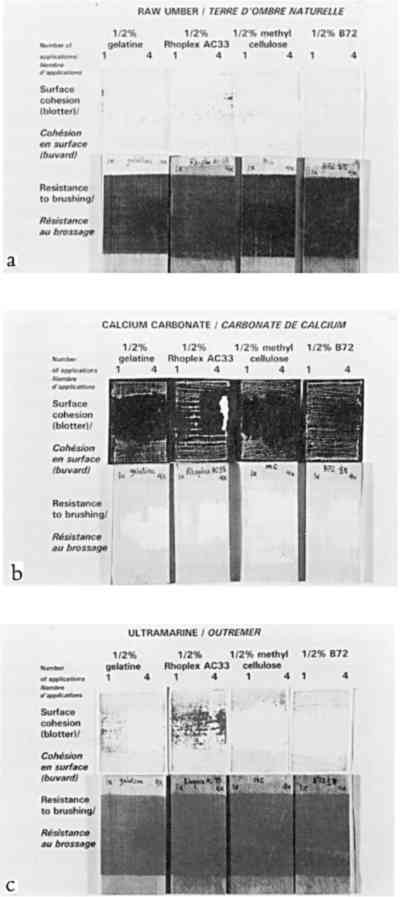ULTRASONIC MISTING. PART 1, EXPERIMENTS ON APPEARANCE CHANGE AND IMPROVEMENT IN BONDINGSTEFAN MICHALSKI, & CAROLE DIGNARD
3 STRENGTH IMPROVEMENT: COHESION AND ADHESION3.1 STRENGTH IMPROVEMENT: MATERIALS TESTEDThe initial strength of the seven pigments under study, when drawn as films with no binder, varied markedly. Green earth and natural red ochre were found to have very strong initial cohesion. They could be touched or lightly stroked by finger without any mechanical harm, and needed to be scratched by fingernail to be damaged. Raw umber also had good initial cohesion, although less than green earth or red ochre. Ivory black and ultramarine were powdery. They transferred pigment particles when touched but had some resistance to blowing by mouth. Calcium carbonate and chrome yellow were easily blown away by mouth. Strength was tested on only three pigments, chosen to cover a range of initial cohesion from moderate to very weak: raw umber (moderate), ultramarine (weak), and calcium carbonate (very weak). There was little to be gained from testing pigments that formed paints stronger than one would ever consider consolidating. The pigments were tested on a wood (pine) substrate, in case a porous substrate affected the results. The 0.5% solutions of the four consolidants described in section 2 were misted as a band through the middle of the samples and were applied once on the proper right side and 4 times on the proper left side of the samples. The thickness of the films are given in table 2. TABLE 2 RESULTS OF THE RESISTANCE OF CONTACT TRANSFERENCE AND RESISTANCE TO BRUSHING ABRASION TEST 3.2 STRENGTH IMPROVEMENT: METHOD OF MEASUREMENTTwo tests were developed: contact transference and brushing abrasion. In the contact test, blotting paper was laid on the surface (black paper for white paint), then a felt cushion, and the sandwich passed through a steel roller mill (used normally for flattening silver). The paper was then inspected for differences in transference, The brushing abrasion test used an automatic draw-down device for paint, modified to draw a stiff, coarse-bristle brush across the paint samples at a constant speed and pressure. The number of passes and the weight were adjusted for each paint to discover differences between treatments, since the initial abrasion resistance of each pigment varied so much. The samples were then inspected for differences in the losses caused by the brush, since treated and untreated areas were side by side. Thus both tests, contact and abrasion, were not absolute comparisons across the three pigments. Absolute comparisons would have required hundreds of tests and yielded trivial results, e.g., the appropriate test for umber would demolish calcium carbonate even at 4 and 10 treatments. These tests measured, for each paint, relative changes in cohesion and adhesion resulting from treatment, given very different initial strengths. 3.3 STRENGTH IMPROVEMENT: RESULTSThe samples are shown in figure 5: at the top are the blotting papers from the contact tests, where transfer of pigment can be observed in some instances; at the bottom are the paints after the brushing abrasion test. The visual assessments are compiled in table 2. Contact tests are given by C, abrasion by A. Two letters (CC or AA) indicate significant improvement to contact or
Exploratory tests used to set the severity of the brush and contact studies demonstrated that calcium carbonate, the weakest of the unconsolidated pigments chosen in this study, though stronger after 4 treatments with the best consolidant, was still more fragile than unconsolidated raw umber. AC-33 was not a successful consolidant. On the blotter contact test, the skin stuck to the blotter and peeled off; with the brush abrasion test, the skin flaked off, leaving a powder residue on the wood. One application of 0.5% gelatin or B-72 gave too weak a bond for two of the three pigments. One application of 0.5% methylcellulose gave fair results, being on average as good as 4 applications of B-72. Within the range studied, all pigments improved the most with 4 Some consolidants could weaken a pigment's initial strength: for example, it was found that 4 applications of B-72 on raw umber gave a weaker bond than the unconsolidated raw umber. |
